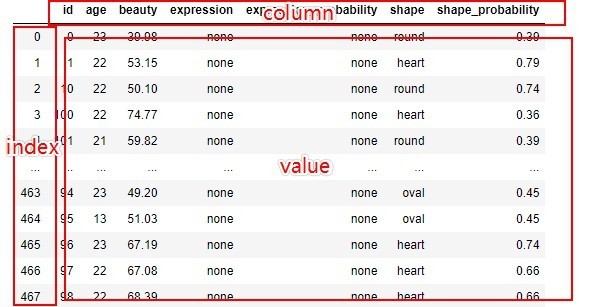| pandas学习之一:excel转字典 | 您所在的位置:网站首页 › excel做词典 › pandas学习之一:excel转字典 |
pandas学习之一:excel转字典
|
1.to_dict() 函数基本语法
DataFrame.to_dict
(self,
orient='dict'
,
into=
) --- 官方文档
函数种只需要填写一个参数:orient 即可 ,但对于写入orient的不同,字典的构造方式也不同,官网一共给出了6种,并且其中一种是列表类型: orient ='dict',是函数默认的,转化后的字典形式:{column(列名) : {index(行名) : value(值) )}};orient ='list' ,转化后的字典形式:{column(列名) :{[ values ](值)}};orient ='series' ,转化后的字典形式:{column(列名) : Series (values) (值)};orient ='split' ,转化后的字典形式:{'index' : [index],‘columns' :[columns],’data‘ : [values]};orient ='records' ,转化后是 list形式:[{column(列名) : value(值)}......{column:value}];orient ='index' ,转化后的字典形式:{index(值) : {column(列名) : value(值)}};备注: 1,上面中 value 代表数据表中的值,column表示列名,index 表示行名,如下图所示:
2,{ }表示字典数据类型,字典中的数据是以 {key : value} 的形式显示,是键名和键值一一对应形成的。 2,关于6种构造方式进行代码实例六种构造方式所处理 DataFrame 数据是统一的,如下: >>> import pandas as pd >>> df =pd.DataFrame({'col_1':[1,2],'col_2':[0.5,0.75]},index =['row1','row2']) >>> df col_1 col_2 row1 1 0.50 row2 2 0.75 2.1,orient ='dict' — {column(列名) : {index(行名) : value(值) )}}to_dict('list') 时,构造好的字典形式:{第一列的列名:{第一行的行名:value值,第二行行名,value值},....}; >>> df col_1 col_2 row1 1 0.50 row2 2 0.75 >>> df.to_dict('dict') {'col_1': {'row1': 1, 'row2': 2}, 'col_2': {'row1': 0.5, 'row2': 0.75}}orient = 'dict 可以很方面得到 在某一列对应的行名与各值之间的字典数据类型,例如在源数据上面我想得到在col_1这一列行名与各值之间的字典,直接在生成字典查询列名为col_1: >>> df col_1 col_2 row1 1 0.50 row2 2 0.75 >>> df.to_dict('dict')['col_1'] {'row1': 1, 'row2': 2} 2.2,orient ='list' — {column(列名) :{[ values ](值)}};生成字典中 key为各列名,value为各列对应值的列表 >>> df col_1 col_2 row1 1 0.50 row2 2 0.75 >>> df.to_dict('list') {'col_1': [1, 2], 'col_2': [0.5, 0.75]}orient = 'list' 时,可以很方面得到 在某一列 各值所生成的列表集合,例如我想得到col_2 对应值得列表: >>> df col_1 col_2 row1 1 0.50 row2 2 0.75 >>> df.to_dict('list')['col_2'] [0.5, 0.75] 2.3,orient ='series' — {column(列名) : Series (values) (值)};orient ='series' 与 orient = 'list' 唯一区别就是,这里的 value 是 Series数据类型,而前者为列表类型 >>> df col_1 col_2 row1 1 0.50 row2 2 0.75 >>> df.to_dict('series') {'col_1': row1 1 row2 2 Name: col_1, dtype: int64, 'col_2': row1 0.50 row2 0.75 Name: col_2, dtype: float64} 2.4,orient ='split' — {'index' : [index],‘columns' :[columns],’data‘ : [values]};orient ='split' 得到三个键值对,列名、行名、值各一个,value统一都是列表形式; >>> df col_1 col_2 row1 1 0.50 row2 2 0.75 >>> df.to_dict('split') {'index': ['row1', 'row2'], 'columns': ['col_1', 'col_2'], 'data': [[1, 0.5], [2, 0.75]]}orient = 'split' 可以很方面得到 DataFrame数据表 中全部 列名或者行名 的列表形式,例如我想得到全部列名: >>> df col_1 col_2 row1 1 0.50 row2 2 0.75 >>> df.to_dict('split')['columns'] ['col_1', 'col_2'] 2.5,orient ='records' — [{column:value(值)},{column:value}....{column:value}];注意的是,orient ='records' 返回的数据类型不是 dict ; 而是list 列表形式,由全部列名与每一行的值形成一一对应的映射关系: >>> df col_1 col_2 row1 1 0.50 row2 2 0.75 >>> df.to_dict('records') [{'col_1': 1, 'col_2': 0.5}, {'col_1': 2, 'col_2': 0.75}]这个构造方式的好处就是,很容易得到 列名与某一行值形成得字典数据;例如我想要第2行{column:value}得数据: >>> df col_1 col_2 row1 1 0.50 row2 2 0.75 >>> df.to_dict('records')[1] {'col_1': 2, 'col_2': 0.75} 2.6,orient ='index' — {index:{culumn:value}};orient ='index'与2.1用法刚好相反,求某一行中列名与值之间一一对应关系(查询效果与2.5相似): >>> df col_1 col_2 row1 1 0.50 row2 2 0.75 >>> df.to_dict('index') {'row1': {'col_1': 1, 'col_2': 0.5}, 'row2': {'col_1': 2, 'col_2': 0.75}} #查询行名为 row2 列名与值一一对应字典数据类型 >>> df.to_dict('index')['row2'] {'col_1': 2, 'col_2': 0.75}
|
【本文地址】
